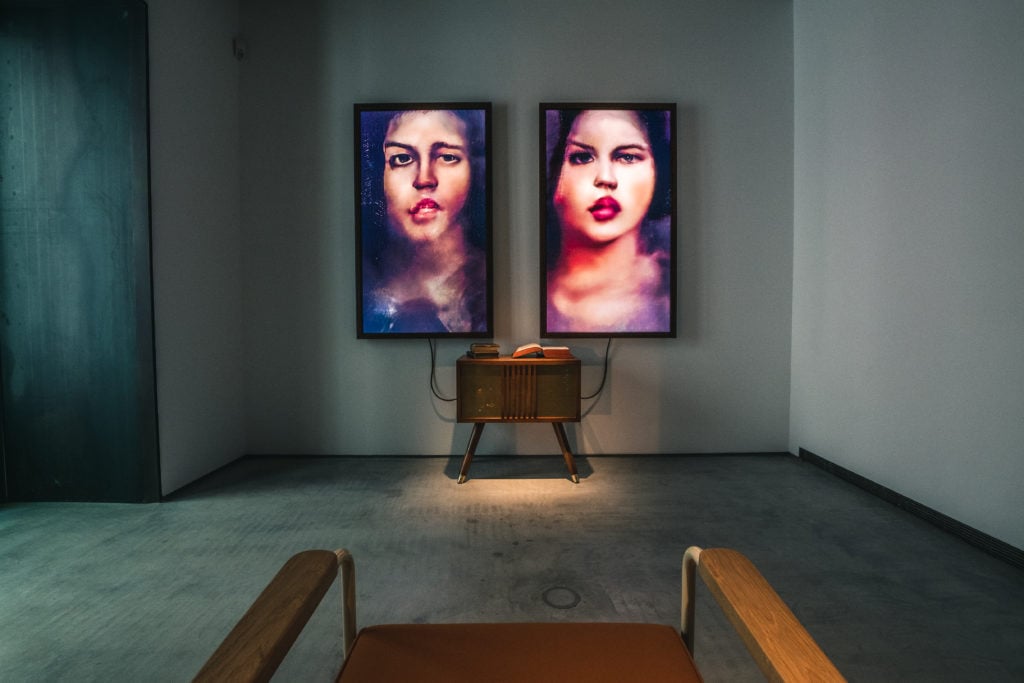Market
Sotheby’s First Auction of an AI Artwork Fails to Incite a Robo-Frenzy, Fetching a Modest $51,000
After a six-figure sale at Christie's in New York, Mario Klingemann's innovative installation that creates surreal portraits sells for $51,000.

After a six-figure sale at Christie's in New York, Mario Klingemann's innovative installation that creates surreal portraits sells for $51,000.

Naomi Rea

Sotheby’s dipped its toes into the market for artwork created using artificial intelligence this morning in London, selling a work by Mario Klingemann titled Memories of Passersby I. The innovative installation by a pioneer of AI art went for £40,000 ($51,012) with fees. The first auction of an AI work in Europe proved to be something of an anticlimax after Christie’s entered the market last October, selling a work attributed to an algorithm for an unprecedented $432,500 in New York.
Klingemann’s work uses neural networks to generate an infinite stream of imaginary portraits, which are projected onto the two-screen installation. The German artist was among the first creative coders to experiment with artificial intelligence and art. The art movement, which Klingemann calls “neurography,” has grown in profile since the Christie’s sale, and many were watching to see whether the rival auction house would match the hype.
The bidding at Sotheby’s started at a more muted £20,000 (or $26,000) and ended just over a minute later with an online bidder securing the work for £32,000 ($42,000), well below its upper estimate of £40,000 ($51,012) without the buyer’s fee.
Like Christie’s in New York, Sotheby’s opted to sell Klingemann’s work in a day sale. However, where the algorithm-attributed work at Christie’s counted among the prints and multiples, Klingemann’s installation was among the early lots in the auction house’s contemporary day sale, which included work by Peter Doig and Harold Ancart, and the sale marked Rose Wylie’s auction debut (her work Listening to Miss S sold for $135,501 with fees). Klingemann’s work hit the block 9th among the sale’s 223 lots. Shortly afterwards, a work by Gerhard Richter reached $1,120,989 with fees, and an untitled 1983 work by Keith Haring fetched $1,243,418 with fees.
Sotheby’s describes Klingemann’s work as creating unique portraits in real time, writing in a statement that, for the viewer, “the experience is something like watching an act of endless imagination take place in the mind of a machine—while the human subject matter of its visions adds a further layer of poignancy.”
Klingemann spent around three months creating the work. He trained the neural network that produces the surreal images based on of thousands of portraits from the 17th to 19th centuries. He also taught it to share his own aesthetic leanings using a Tinder-like selection process. In the installation, the computer generates new faces as you watch it, each strange feature morphing into the next, sometimes stuttering as it “thinks” about the next image. The end result is something that Sotheby’s likens to the simultaneously disturbing and appealing “convulsive beauty” of the French writer behind the first Surrealist Manifesto, André Breton.
Another edition of the work is currently on view at the Colección Solo in Madrid. Other examples of Klingemann’s work have been shown at the Ars Electronica Festival, MoMA and the Met in New York. In 2018 he received the Lumen Prize which recognizes artwork created with technology.
Sotheby’s contemporary art specialist Marina Ruiz Colomer presented the piece as a breakthrough when the sale was announced in February. “It is the nature of Contemporary Art to push boundaries,” she said. “AI art is the latest innovation winning its place in art history books, and Klingemann’s work stands on the precipice of an exciting new era in our field.”